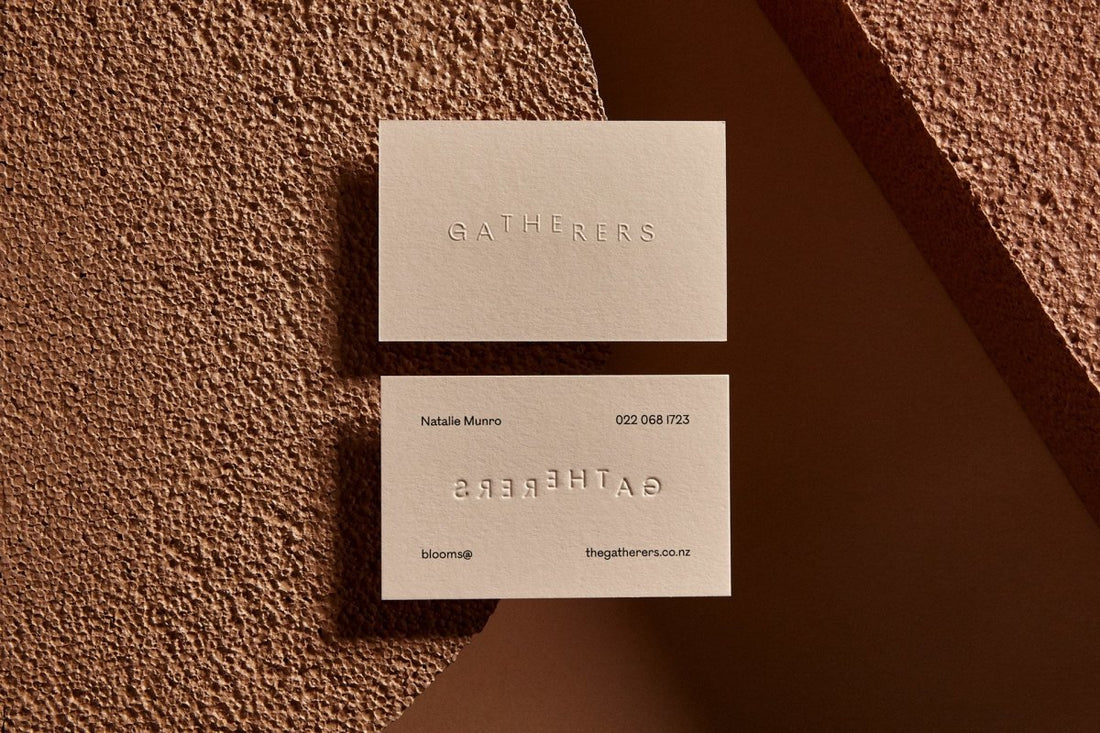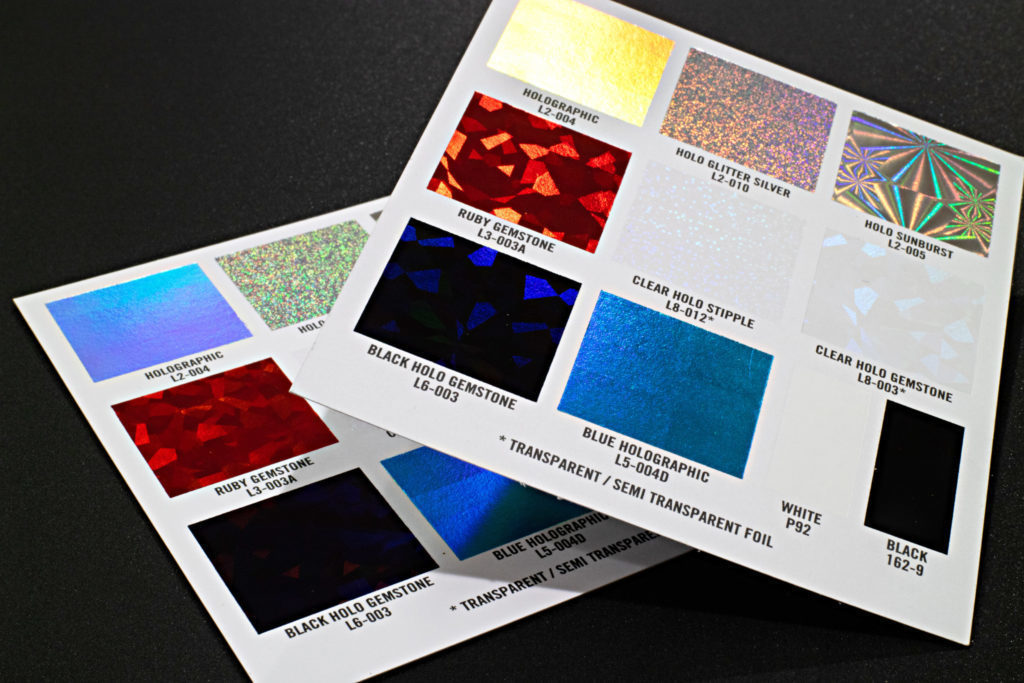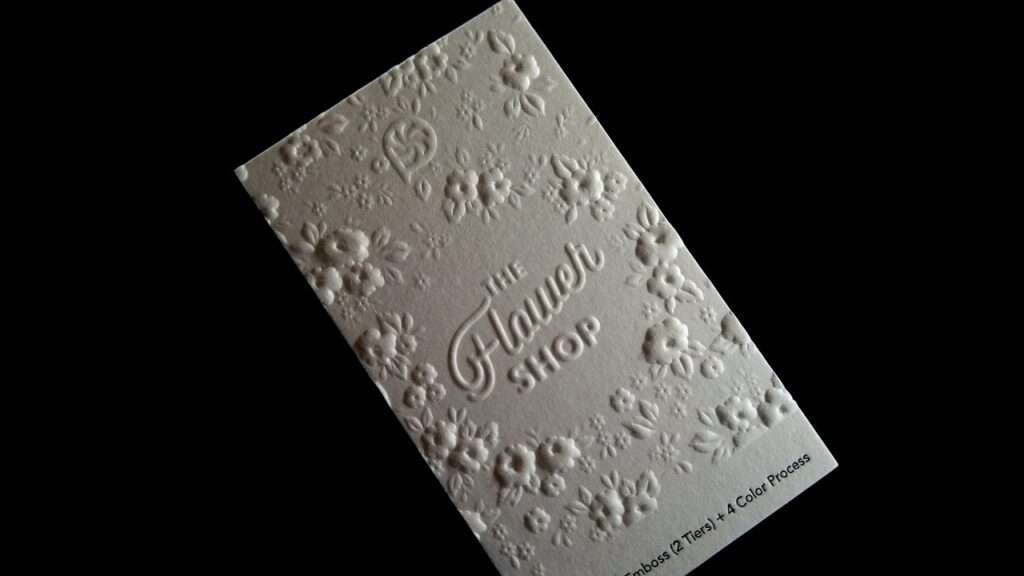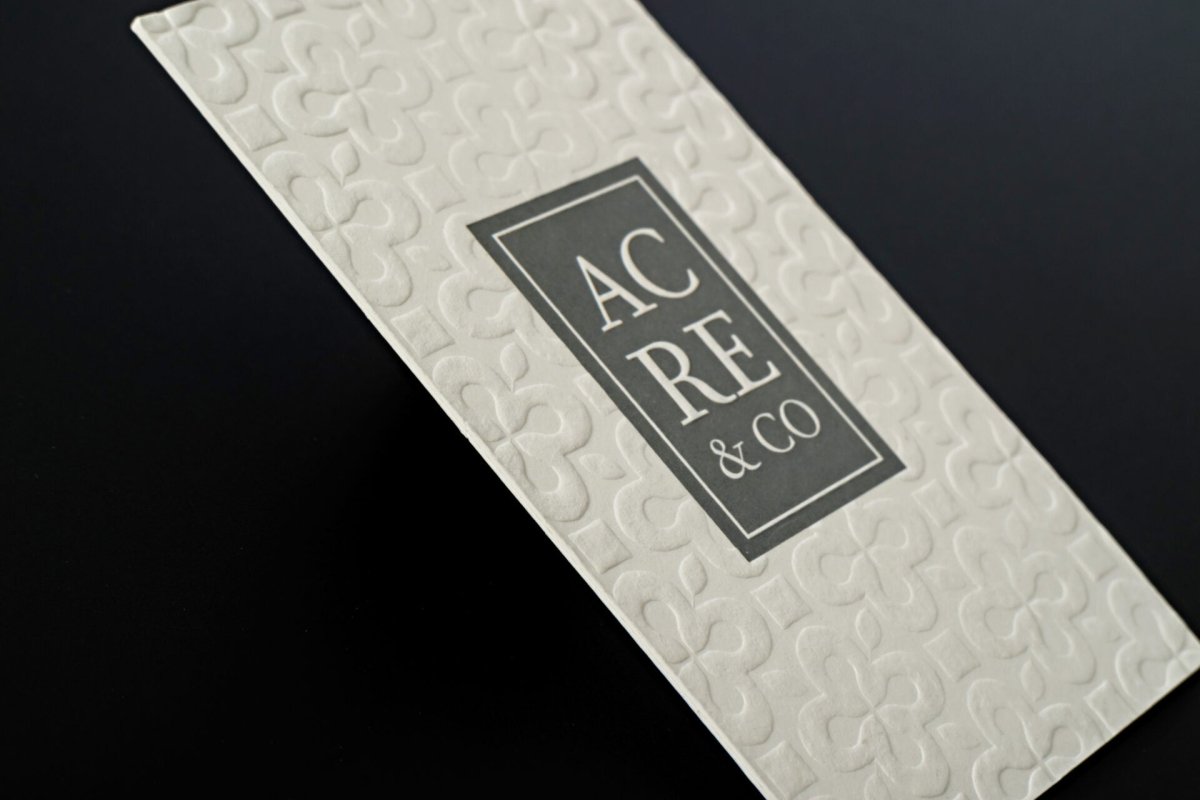
Embossing vs Debossing: An In-depth Guide
adminShare
Image Source: https://www.behance.net/gallery/83389183/The-Gatherers
Have you ever been to an art gallery or museum and felt a need to touch a textured artwork?
We know the feeling, and hope you didn’t touch the valuable fine art.

Fortunately for you, using texture isn’t limited to just fine art. You can use texture in your projects for people to touch.
Adding texture to business cards, packaging, marketing collateral, and other projects is a great way to engage existing and potential customers. It adds an extra sensory experience beyond just the visuals.
This is where embossing and debossing come in. Both add texture, elegance, and professionalism to your design elements, type, or logos but in different ways.
Here are some tips and tricks to get the most out of your embossing or debossing project.
Embossing vs. Debossing
Embossing and debasing add topography and texture to your project. Both are forms of imprinting that use a metal plate to press into the paper or card stock.

Adding embossing or debossing gives the viewer another way to experience the project. This works for business cards, marketing collateral, and other promotional work.
So, what’s the difference between embossing vs. debossing?
Embossing creates an image or text that raises from the plane of the material.
Debossing pushes down into the material causing the image or text to recess into the material.
When used properly, embossing and debossing add a level of sophistication that can improve the visual appeal of your brand. This is especially true for business cards and company promotional materials.
About Embossing
When you have an item embossed, the printing company will use a die and a counter die which have the etching of the design you wish to emboss. The emboss die made with metal presses from above.
The counter die consists of epoxy, fiberglass, or magnesium plates. It fits tightly into the emboss die when pressed together.

The print shop feeds card stock or paper between the die and the counter die. The dies push into the paper and each other using a great amount of pressure and heat to raise one side of the paper creating the embossment.
It’s worth mentioning that a true emboss will create a raised image on one side and a deboss on the other. If you’re planning to use both sides of the paper or card, try incorporating the deboss in the design.

Or, ask for a duplex laminated double layered card in which two pieces of card stock are glued together. The 2nd layer will cover up the deboss on the backside of the first paper layer.
This leaves the final image raised from the surrounding material. It’s a 3D image that is both visually and texturally stimulating. Embossing works for text, images, borders, and more.
But you can make your design more intricate and unique. You’re only limited by your creativity.
The most common forms of embossing use a single-level die. This raises only the text or primary elements of an image from the paper. Your embossed image will raise about 1/64th of an inch from the paper.
Multi-Level "3D" Embossing
A multi-level embossing technique uses a die with 2 or more levels to create text and imagery that appears fully 3D. For example, imagine you want to emboss a lion’s head. With multi-level embossing, you can make the lion’s head appear like a 3-dimensional relief sculpture.
Embossing can get very detailed, too. If you want your embossment to include the tiniest of details, well it sure can.
Single-level embossing is a great choice for packaging, marketing collateral, business cards, and more. Due to the complexity of multi-level embossing, it’s a better choice for high-end packaging and promotional stationery, posters, and brochures.
If you choose to pursue multi-level embossing, make sure you invest in quality heavy paper or card stock. Thin paper will not hold up as well with the embossment leaving you quite sad when you receive your final product.
After your piece has the embossing you can choose to leave it white or the color of the material. Or add a little personality to it by using foil or ink to cover the emboss.
About Debossing
Debossing is similar to embossing but in reverse. It creates a depressed image in front of your paper or project. And just like embossing, it uses 2 dies and heavier paper to achieve the deboss.
Except with debossing, the print company switches the emboss die and the counter die. The metal embossing die will press down into the card to create a detailed deboss.
Other than the reversal of the die, the process is the same as embossing. A combination of applied high pressure and heat create the debossed image.
An advantage of debossing is it doesn’t affect the back of your card or material as much as an embossed image. If you’re planning to use the backside of the card or material, you’ll have more freedom.
Unless you plan to create a multi-level debossed image. Yes, you bet you can do multi-level debossing with your business cards and other projects. As mentioned above, you’ll want to use thicker quality paper to ensure the debossed holds.
Do you want to add color or foil to your debossed image? Well, you certainly can do just that. Whether or not you add color, a debossed image will add an elegant and professional touch to your projects.
Popular Embossing Effects
On top of choosing what to emboss or deboss, you have to choose the type of effect. The most popular options include raised round, raised roof, and raised flat.
A raised round emboss effect leaves the edges of the embossment rounded and curved. There are no sharp angles or edges.
In contrast, a raised flat effect uses flat surfaces and sharp edges to create an image. With this style, the edges have a bevel.
Then there is the raised roof, a common effect used for debossing. It looks makes a v-shaped imprint.
Don’t feel limited to having to use one type. With multi-level embossing and debossing, you can mix and match the different effects. For example, the first level can use a raised rounded effect while the second uses a raised flat effect.
Other Embossing Terms
Believe it or not, the embossing terminology doesn’t end there. There are many terms you’re sure to hear when you plan to add embossing or debossing to your work.
Blind Embossing
If you’re planning to emboss (or deboss) a business card or project, your printing company will want to know whether it will be a blind emboss. A blind emboss is simply an embossed image without ink or foil. It only uses the texture created from the die and the material.
Combination Embossing
Remember when we learned about mixing different types of embossing effects to an image? Well, it’s known as combination embossing. It also incorporates foil to cover the entire embossed or debossed image.
Registered Embossing
Registered embossing takes combination embossing but adds another element. This can include ink, foil, punching, or other embossing effects.
A Sculpted Die
If you’re looking for a truly impressive form of embossing or debossing, then using a sculpted die will set your embossing apart from the rest. The final embossment will look like a relief sculpture.
To achieve this, someone will create the die by hand based on the image you wish to emboss. It uses many levels and has a high level of detail.
This is a slower and more expensive form of embossing and debossing. However, with the right artist, you’ll have a very impressive embossing on your cards or packaging.
Textured Die
Unlike the effects described above, this form of embossing uses a single-level die with texture etched into it. This detail can be a simple pattern or complex design.
Using Embossing vs. Debossing
The ways you can use embossing and debossing in your designs are limitless—at least as limitless as your creativity. However, not all images and logos work well embossed or debossed.
Here are a few tips on how to use embossing and debossing to make your designs stand out from the rest.
Vector Art
Start with a vector version of your final design rather than a rasterized image. Because vector art consists of mathematical rules, it’s easier to scale larger or smaller. It will hold a high level of detail and quality when recreated with laser on the die.
Embossing the Right Areas
If you really want to cover your business cards or projects with embossing or debossing, you can. But there’s no promise it will turn out well.
Our advice, limit your embossing and debossing to your company logos, text, single images, and embellishment. Using it as an accent will look more pleasing to the eye.
The exception is patterns. Adding a repeating element in the background of a business card adds a touch of class to your design.
Use Heavier Paper and Card Stock
Yes, we’ve said this before and will say it again, invest in heavier paper and/or card stock. Thicker paper will hold the embossed or debossed imagery better. It also shows off more detail and depth.
Using Multi-Level Embossing & Debossing
Multi-level embossing and debossing work best with larger images. This style of embossing and debossing presses deeper in the paper which can cause it to tear if the image is too small.
Keep it Simple
Since embossing turns a 2-dimensional image into a 3-dimensional one, it works best with simpler designs. Using color, shading, and other elements to make your image appear 3D may contort the image when it gets embossed.
Can an embossed image hold a high level of detail? Yes, it can. It will require a reputable artist, time, and a lot more money.
So while you can add extra detail doesn’t mean you should.
Color and Foil
Add color and foil to let your design pop. It’s a way to grab the viewer’s attention. But again, when used right. Too much color or foil can muddle the embossment.
Less is More
No matter how cliché it might sound, when it comes to design, sometimes less is more. This is especially true for embossing.
With the many types of effects you can add to your embossing and debossing, it’s easy to get carried away. If not done right, you’ll end up with a heap of color and texture. The professional-quality you were planning ended up going out the window.
Fortunately, you can avoid this. Start your ideas out as blind embossed or debossed images. Slowly add and experiment with different effects and colors if you feel your image needs more.
Textured Paper
Using textured paper can help make your blind embossed and debossed images stand out without color. During the embossing process, the area embossed becomes smoother when pressed. The texture surrounding the embossed image will help it stand out.
Embossing Vs. Debossing: Is One Better?
Are you wondering if embossing or debossing is better, well, that’s up for you decide. However, debossing is the more popular option for imprinting logos, stamps, and more.
Embossing is a popular imprinting choice for accents and embellishments. Think edges on a napkin or a border around a business card. Embossing isn’t as common for customized designs because it tends to cost more.
At the end of the day, your design, project, and budget will help you decide between embossing vs. debossing.
Other Considerations
Can’t decide between embossing vs. debossing your next project? Here are a few more considerations worth checking out.
Costs
Debossing usually costs less than embossing. Embossing almost always uses 2 dies when creating an image making it more labor-intensive and requiring more materials. There are cases where debossing uses 2 dies but it’s more common to use just one etched die.
Blind embossing and debossing will save you money on your projects. Ink and foil will add more costs to your designs.
Materials
You can emboss just about anything that is a thin malleable material. However, materials such as paper, textiles, some plastics, and metals can withstand the heat during the embossing and debossing process.
Other materials that are good for embossing include plastic film, textiles, and leather. If you’re unsure, ask a professional at the printing company and do your research.
Emboss and Deboss Like a Boss
With these tips, you can make confident design decisions between embossing vs. debossing. Your next set of business cards, marketing collateral, or packaging will look elegant and professional.
Make 2020 the year your business cards and designs go beyond the ordinary. Check out our custom design services to keep your company’s designs attractive and effective.




